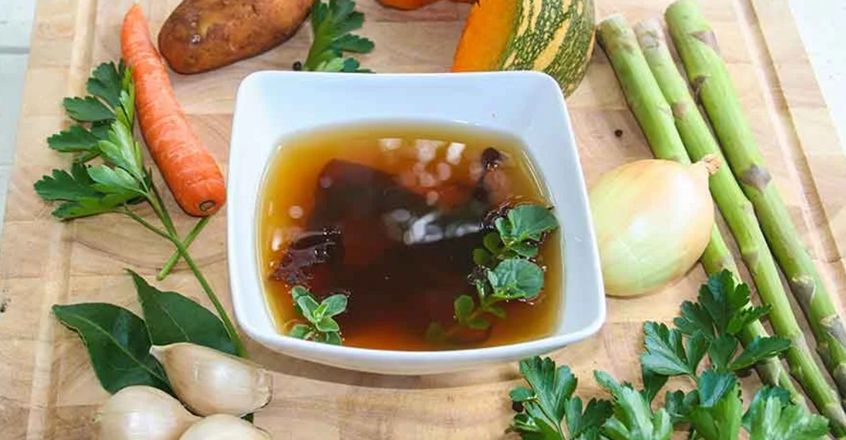The Bone Broth Fad

If you desire the truth about what is REAL in terms of food and nutrition, please sign up for our newsletters. The bone broth fad is back again so I have addressed below why you should avoid this toxic potion and focus on my magic mineral broth instead.
Soups and broths have been a regular feature in cooking since before historical records. In fact, one of the oldest books in Chinese medicine is Dr. Yi Yins Soup Classic.[1] In the West we can look to Hippocrates, the Father of Western medicine. He was fond of recommending barley soup to his patients. What we know is that when a person is ill, they may find it easier to drink a restorative soup than eat a full meal. Soups have been used for many reasons.
The bone broth fad, which consists of boiling bones and tissue as a strengthening tonic, is a little strange for a number of reasons:
- A number of nutritional studies show that animal source fats and protein are harmful to health.
- Heavy metals and other toxic compounds ingested by animals–including those raised for food– have a tendency to accumulate in fatty tissue.
- The history of boiling bones and other tissues that are difficult to eat undoubtedly began as a way of gleaning every possible bit of nutrition from the body of animals killed for food–either hunted or farmed–in times of food shortages.
In my experience, whole, nutritious vegetables are all that’s needed for some of the most healing and restorative soups and broths you can make. The broth below is a favorite with my clients. It contains ingredients that are energizing and extremely nutritious. Three ingredients in the broth may be unfamiliar to some readers. They are specific foods that are used in the traditions of China and Japan and have some fascinating qualities. As a long-time teacher and health counsellor of macrobiotics, I use these fantastic ingredients in many of my soups and broths.
Kombu Seaweed
According to Professor Arasaki of the University of Tokyo, sea vegetables contain more minerals than any other food. All the 56 elements essential for human health are present in sea vegetables, including many trace minerals that are often lacking in modern produce due to demineralization of the soil. This may be why the people of Okinawa seldom show signs of mineral depletion and live long lives.[2]
According to Professor Arasaki of the University of Tokyo, sea vegetables contain more minerals than any other food.
Scientists at McGill University in Canada showed that sodium alginate—one of the chemical compounds found in kombu—removes radioactive elements and heavy metals from the system.
Shiitake Mushrooms
Shiitake mushrooms are well known for their use in traditional medicine. Among the many mushrooms that have been tested for unique chemical properties, they have always stood out. In 1936, Dr. Kisaku Mori established the Institute of Mushroom Research in Tokyo. Until his death in 1977, he worked with scientists from around the world to document the medicinal effects of shiitake.
Mori’s work gained significant attention, particularly in Japanese medicinal circles, and beginning in the 1960s, scientists launched an extensive search to uncover the secret of shiitake mushrooms’ legendary healing powers. Their studies—about one hundred—all focused on shiitake mushrooms’ ability to rapidly lower serum cholesterol, as well as its potent antitumor, antiviral, and antibiotic properties.
Shiitake mushrooms were also found to have antifungal and antioxidant properties,[3][4] and to reduce toxicity in the liver. [5]
I offer all my clients and students a big mug of my fabulous broth at all my classes and workshops. You can join me in the kitchen in this video and make a big pot of this delicious and nutritious drink for yourself and your family. I also keep this broth on hand as a soup stock.
Marlene’s Vegetable Mineral Broth
A vegetable broth made from organically grown vegetables can be an excellent source of essential electrolytes. Ionic minerals are the key to maintaining good health. The broth is a wonderful, filling snack that will also provide you with many healthy nutrients that will help you feel great. The recipe can be varied to suit your taste.
References
- Sho H, ‘History and characteristics of Okinawan longevity food’ Asia Pacific Journal of Clinical Nutrition 10 (2001):159
- Sho H, ‘History and characteristics of Okinawan longevity food’ Asia Pacific Journal of Clinical Nutrition 10 (2001):159
- The plant defensin RsAFP2 induces cell wall stress, septin mislocalization and accumulation of ceramides in Candida albicans Karin Thevissen , Patricia de Mello Tavares, Deming Xu , Jill Blankenship, Davy Vandenbosch, Jolanta Idkowiak‐Baldys, Gilmer Govaert, Anna Bink, Sonia Rozental – 05 March 2012 – https://doi.org/10.1111/j.1365-2958.2012.08017.x
- Nutrients. 2017 Sep; 9(9): 1014. Published online 2017 Sep 14. doi: 10.3390/nu9091014, PMCID: PMC5622774 PMID: 28906451 Radish (Raphanus sativus) and Diabetes , Saleem Ali Banihani
- Toxicol Res. 2012 Sep; 28(3): 165–172, doi: 10.5487/TR.2012.28.3.165, PMCID: PMC3834419, PMID: 24278606 – Effects of White Radish (Raphanus sativus) Enzyme Extract on Hepatotoxicity – Sang Wha Lee, Kwang Mo Yang, Jung Ki Kim, Byung


